Fierce deities
In Buddhism, fierce deities are the fierce, wrathful or forceful (Tibetan: trowo, Sanskrit: krodha) forms of enlightened Buddhas, Bodhisattvas or Devas (divine beings). Because of their power to destroy the obstacles to enlightenment, they are also termed krodha-vighnantaka, "fierce destroyers of obstacles".[1] Fierce deities are a notable feature of the iconography of Mahayana and Vajrayana Buddhism. These types of deities first appeared in India during the late 6th century with its main source being the Yaksha imagery and became a central feature of Indian Tantric Buddhism by the late 10th or early 11th century.[2]
Overview
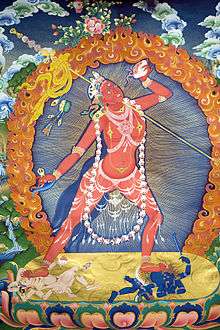
In non-Tantric traditions of Mahayana Buddhism, these beings are protector deities who destroy obstacles to the Buddhas and the Dharma, act as guardians against demons and gather together sentient beings to listen to the teachings of the Buddhas.[3] In Tantric Buddhism, they are considered to be fierce and terrifying forms of Buddhas and Bodhisattvas themselves. Enlightened beings may take on these forms in order to protect and aid confused sentient beings.[4] They also represent the energy and power that is needed in order to transform negative mental factors into wisdom and compassion.[5][6] They represent the power and compassion of enlightened activity which uses multiple skillful means (upaya) to guide sentient beings as well as the transformative element of tantra which uses negative emotions as part of the path. According to Chogyam Trungpa, "wrathful yidams work more directly and forcefully with passion, aggression, and delusion - conquering and trampling them on the spot."[7]
In Tantric Buddhist art, fierce deities are presented as terrifying, demonic looking beings adorned with human skulls and other ornaments associated with the charnel ground, as well as being often depicted with sexually suggestive attributes. According to Rob Linrothe, the sensual and fierce imagery represents "poison as its own antidote, harnessed obstacles as the liberating force" and notes that they are "metaphors for the internal yogic processes to gain enlightenment".[8]
Tantric Deities
Yidams
In Indo-Tibetan Vajrayana, Yidams are divine forms of Buddhas and Bodhisattvas. The tantric practitioner is initiated into the mandala of a particular chosen deity (Sanskrit: Iṣṭa-devatā) and practices complex sadhanas (meditations) on the deity for the purpose of personal transformation.[9] This Deity Yoga practice is central to tantric forms of Buddhism such as Tibetan Buddhism. Yidams can be peaceful, fierce and "semi-fierce" (having both fierce and peaceful aspects). Fierce deities can be divided into male and female categories.[10] The Herukas (Tb. khrag 'thung, lit. "blood drinker") are enlightened masculine beings who adopt fierce forms to express their detachment from the world of ignorance, such as Yamantaka, Cakrasamvara, Mahākāla, or Vajrakilaya. Dakinis (Tb. khandroma, "sky-goer") are their feminine counterparts, sometimes depicted with a heruka and sometimes as independent deities. The most prevalent wrathful dakinis are Vajrayogini and Vajravārāhī.
Gallery
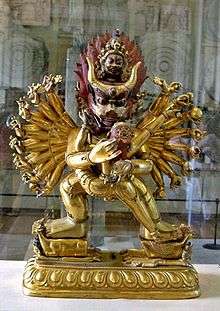 Yamantaka, also known as Vajrabhairava.
Yamantaka, also known as Vajrabhairava.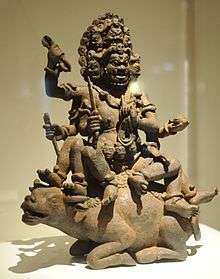 Yamantaka statue
Yamantaka statue Yamantaka thangka
Yamantaka thangka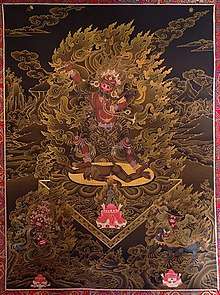 Ekajati, also known as Blue Tara or Ugra Tara.
Ekajati, also known as Blue Tara or Ugra Tara.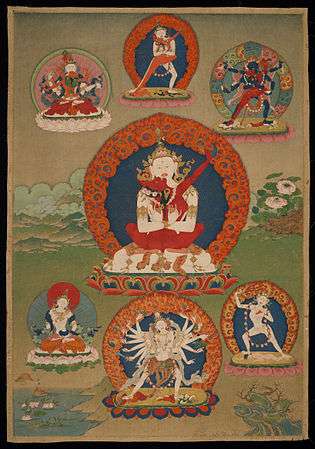 Chakrasamvara, a semi-wrathful deity, depicted in yab-yum with consort
Chakrasamvara, a semi-wrathful deity, depicted in yab-yum with consort Tibetan statue of standing Chakrasamvara and consort
Tibetan statue of standing Chakrasamvara and consort 6-arm Mahakala
6-arm Mahakala Painted statue of Mahakala
Painted statue of Mahakala.jpg)
_LACMA_M.90.195.jpg) Dancing Vajravarahi (Dorje Pagmo)
Dancing Vajravarahi (Dorje Pagmo)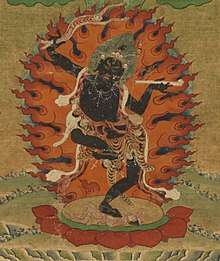 Troma Nagmo
Troma Nagmo
 The Herukas of the Guhyagarbha Tantra
The Herukas of the Guhyagarbha Tantra Kalachakra and Core Assembly.
Kalachakra and Core Assembly. Kalachakra statue
Kalachakra statue_16th_century_Boston_MFA.jpg)
Wisdom Kings
In East Asian Buddhism, Wisdom Kings (Sanskrit vidyarāja), are seen as divine manifestations of the Buddhas, who act as protectors, messengers and defenders of the Buddhist Dharma.[11] In East Asian Vajrayana and Chinese Esoteric Buddhism the five wisdom kings are manifestations of the Five Tathagatas.
Gallery
- Acala, "The Immovable One" - manifestation of Buddha Mahavairocana
 Vajrayaksa, "The Devourer of Demons" - manifestation of Buddha Amoghasiddhi
Vajrayaksa, "The Devourer of Demons" - manifestation of Buddha Amoghasiddhi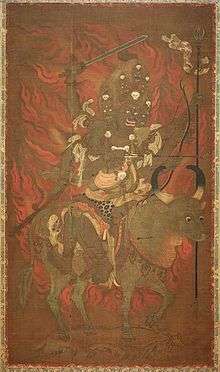 Vajrabhairava, "The Defeater of Death" - manifestation of Buddha Amitābha
Vajrabhairava, "The Defeater of Death" - manifestation of Buddha Amitābha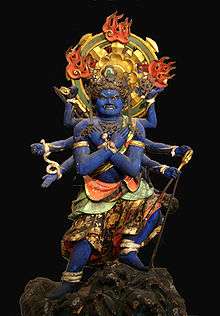 The Wisdom king Kundali, "The Dispenser of Heavenly Nectar" - manifestation of Buddha Ratnasambhava
The Wisdom king Kundali, "The Dispenser of Heavenly Nectar" - manifestation of Buddha Ratnasambhava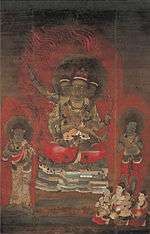 Trailokyavijaya, "The Conqueror of The Three Planes" - manifestation of Buddha Akshobhya
Trailokyavijaya, "The Conqueror of The Three Planes" - manifestation of Buddha Akshobhya
The Protectors
The Protectors (Sanskrit pāla) or Dharmapāla (Dharma protectors), are powerful beings, often Devas or Bodhisattvas who protect the Buddhist religion and community from inner and outer threats and obstacles to their practice.[12] A Dharmapala can also be a Garuda, Nāga, Yaksha, Gandharva, or Asura.[13] Other categories of Protectors include the Lokapālas or "Four Heavenly Kings" and Kṣetrapālas or "Protectors of the Region".
Eight Dharmapalas
A common Tibetan grouping of Dharmapāla is 'The Eight Dharmapalas' (Tibetan: དྲག་གཤེད, Wylie: drag gshed ), who are understood to be the defenders of Buddhism. They are supernatural beings with the rank of bodhisattva who "are supposed to wage war without any mercy against the demons and enemies of Buddhism".[14] The Eight Dharmapala are:[15]
- Yama, the god of death
- Mahakala, the Great Black One
- Yamantaka, the conqueror of death
- Vaiśravaṇa or Kubera, the god of wealth
- Hayagriva, the Horse-necked one
- Palden Lhamo, female protectress of Tibet
- White Brahma or Tshangs pa
- Begtse, a war god from Mongolia.
Gallery
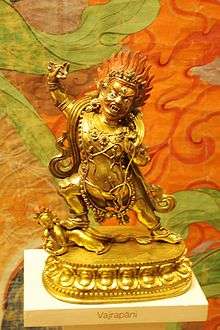
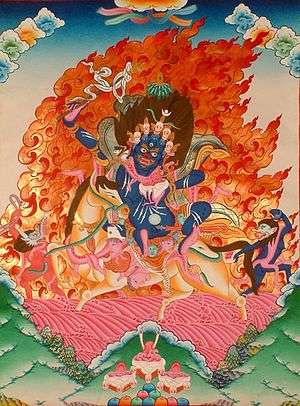
 Japanese Vaiśravaṇa (Bishamonten), one of the four Heavenly Kings, at Todaiji
Japanese Vaiśravaṇa (Bishamonten), one of the four Heavenly Kings, at Todaiji.jpg) A thai depiction of Vaiśravaṇa (Vessavana).
A thai depiction of Vaiśravaṇa (Vessavana).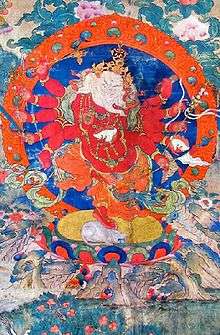
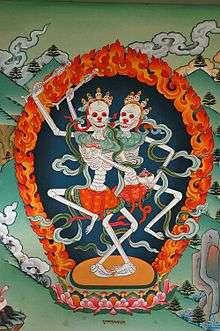
_and_Consort_on_Bull%2C_Nyingmapa_Buddhist_or_Bon_Ritual_Card_LACMA_AC1998.253.1.jpg) Yama, lord of death
Yama, lord of death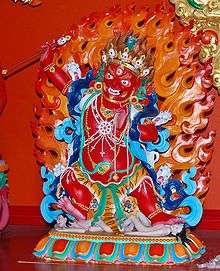 Hayagriva, the "horse-necked"
Hayagriva, the "horse-necked" Rahula, an oath-bound protector of Dzogchen
Rahula, an oath-bound protector of Dzogchen- Virūpāksa - King of the West, one of the Four Heavenly Kings at Wolijeongsa, Korea
See also
References
- ↑ Linrothe, Rob. Ruthless Compassion, 1999, page 12.
- ↑ Linrothe, Rob. Ruthless Compassion, 1999, page x, 12.
- ↑ Linrothe, Rob. Ruthless Compassion, 1999, page 13, 25.
- ↑ Thurman, Robert. The Tibetan Book of the Dead: Liberation Through Understanding in the Between, page 149.
- ↑ Berzin, Alexander; Making Sense of Tantra, https://studybuddhism.com/en/advanced-studies/vajrayana/tantra-theory/making-sense-of-tantra/tantric-imagery#peaceful-and-forceful-figures
- ↑ Linrothe, Rob. Ruthless Compassion, 1999, page xi.
- ↑ Chögyam Trungpa. The Collected Works of Chögyam Trungpa: Volume 3, Shambala, 2003, page 438.
- ↑ Linrothe, Rob. Ruthless Compassion, 1999, page xi-xii.
- ↑ Buswell, Robert E.; Lopez, Donald S. (2013). The Princeton dictionary of Buddhism. Princeton and Oxford: Princeton University Press. ISBN 978-0-691-15786-3.
- ↑ Wrathful Deities
- ↑ Baroni, Helen Josephine (2002). The illustrated encyclopedia of Zen Buddhism. New York: Rosen Pub. Group. p. 100. ISBN 0-8239-2240-5.
- ↑ Heart Jewel: The Essential Practices of Kadampa Buddhism, pages 71-3, Tharpa Publications (2nd. ed., 1997) ISBN 978-0-948006-56-2
- ↑ Robert E. Buswell Jr.; Donald S. Lopez Jr. (2013). The Princeton Dictionary of Buddhism. Princeton University Press. pp. 249–250. ISBN 978-1-4008-4805-8.
- ↑ "Wrathful Guardians of Buddhism - Aesthetics and Mythology". February 2001. Retrieved 2008-08-31.
- ↑ Pearlman, Ellen. Tibetan Sacred Dance: A Journey into the Religious and Folk Traditions, page
External links
- Wrathful Guardians of Buddhism - Aesthetics and Mythology
- Wrathful Deities
- Sacred visions : early paintings from central Tibet, fully digitized text from The Metropolitan Museum of Art libraries